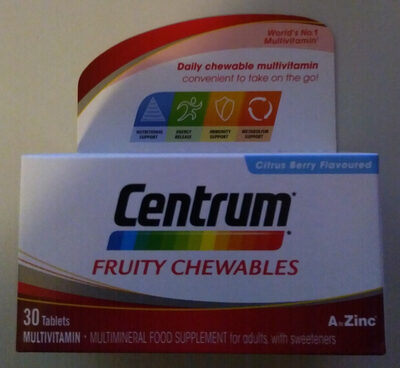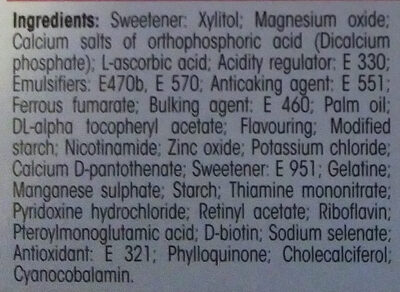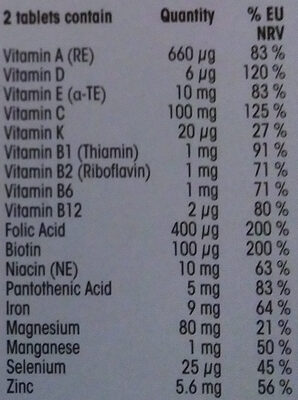Help us make food transparency the norm!
As a non-profit organization, we depend on your donations to continue informing consumers around the world about what they eat.
The food revolution starts with you!
Centrum Fruity Chewables Multivitamin - 30 Tablets
Centrum Fruity Chewables Multivitamin - 30 Tablets
This product page is not complete. You can help to complete it by editing it and adding more data from the photos we have, or by taking more photos using the app for Android or iPhone/iPad. Thank you!
×
Barcode: 5000309008276 (EAN / EAN-13)
Quantity: 30 Tablets
Packaging: Card-box
Categories: Dietary supplements
Stores: Sainsbury's
Countries where sold: United Kingdom
Matching with your preferences
Health
Ingredients
-
41 ingredients
Sweetener: Xylitol; Magnesium oxide; Calcium salts of orthophosphoric acid (Dicalcium phosphate); L-ascorbic acid; Acidity regulator: E 330; Emulsifiers: E470b, E 570; Anticaking agent: E 551; Ferrous fumarate; Bulking agent: E 460; Palm oil; DL-alpha tocopheryl acetate; Flavouring: Modified starch; Nicotinamide; Zinc oxide; Potassium chloride; Calcium D-pantothenate; Sweetener: E 951; Gelatine; Manganese sulphate; Starch; Thiamine mononitrate; Pyridoxine hydrochloride; Retinyl acetate; Riboflavin; Pteroylmonoglutamic acid; D-biotin; Sodium selenate; Antioxidant: E 321; Phylloquinone; Cholecalciferol; Cyanocobalamin.
Food processing
-
Ultra processed foods
Elements that indicate the product is in the 4 - Ultra processed food and drink products group:
- Additive: E14XX - Modified Starch
- Additive: E428 - Gelatine
- Additive: E460 - Cellulose
- Additive: E470b - Magnesium salts of fatty acids
- Additive: E551 - Silicon dioxide
- Additive: E951 - Aspartame
- Additive: E967 - Xylitol
- Ingredient: Bulking agent
- Ingredient: Emulsifier
- Ingredient: Flavouring
- Ingredient: Sweetener
Food products are classified into 4 groups according to their degree of processing:
- Unprocessed or minimally processed foods
- Processed culinary ingredients
- Processed foods
- Ultra processed foods
The determination of the group is based on the category of the product and on the ingredients it contains.
Additives
-
E321 - Butylated hydroxytoluene
Butylated hydroxytoluene: Butylated hydroxytoluene -BHT-, also known as dibutylhydroxytoluene, is a lipophilic organic compound, chemically a derivative of phenol, that is useful for its antioxidant properties. European and U.S. regulations allow small amounts to be used as a food additive. In addition to this use, BHT is widely used to prevent oxidation in fluids -e.g. fuel, oil- and other materials where free radicals must be controlled.Source: Wikipedia
-
E330 - Citric acid
Citric acid is a natural organic acid found in citrus fruits such as lemons, oranges, and limes.
It is widely used in the food industry as a flavor enhancer, acidulant, and preservative due to its tart and refreshing taste.
Citric acid is safe for consumption when used in moderation and is considered a generally recognized as safe (GRAS) food additive by regulatory agencies worldwide.
-
E341 - Calcium phosphates
Calcium phosphate: Calcium phosphate is a family of materials and minerals containing calcium ions -Ca2+- together with inorganic phosphate anions. Some so-called calcium phosphates contain oxide and hydroxide as well. They are white solids of nutritious value.Source: Wikipedia
-
E341ii - Dicalcium phosphate
Calcium phosphate: Calcium phosphate is a family of materials and minerals containing calcium ions -Ca2+- together with inorganic phosphate anions. Some so-called calcium phosphates contain oxide and hydroxide as well. They are white solids of nutritious value.Source: Wikipedia
-
E460 - Cellulose
Cellulose: Cellulose is an organic compound with the formula -C6H10O5-n, a polysaccharide consisting of a linear chain of several hundred to many thousands of β-1→4- linked D-glucose units. Cellulose is an important structural component of the primary cell wall of green plants, many forms of algae and the oomycetes. Some species of bacteria secrete it to form biofilms. Cellulose is the most abundant organic polymer on Earth. The cellulose content of cotton fiber is 90%, that of wood is 40–50%, and that of dried hemp is approximately 57%.Cellulose is mainly used to produce paperboard and paper. Smaller quantities are converted into a wide variety of derivative products such as cellophane and rayon. Conversion of cellulose from energy crops into biofuels such as cellulosic ethanol is under development as a renewable fuel source. Cellulose for industrial use is mainly obtained from wood pulp and cotton.Some animals, particularly ruminants and termites, can digest cellulose with the help of symbiotic micro-organisms that live in their guts, such as Trichonympha. In human nutrition, cellulose is a non-digestible constituent of insoluble dietary fiber, acting as a hydrophilic bulking agent for feces and potentially aiding in defecation.Source: Wikipedia
-
E551 - Silicon dioxide
Silicon dioxide: Silicon dioxide, also known as silica, silicic acid or silicic acid anydride is an oxide of silicon with the chemical formula SiO2, most commonly found in nature as quartz and in various living organisms. In many parts of the world, silica is the major constituent of sand. Silica is one of the most complex and most abundant families of materials, existing as a compound of several minerals and as synthetic product. Notable examples include fused quartz, fumed silica, silica gel, and aerogels. It is used in structural materials, microelectronics -as an electrical insulator-, and as components in the food and pharmaceutical industries. Inhaling finely divided crystalline silica is toxic and can lead to severe inflammation of the lung tissue, silicosis, bronchitis, lung cancer, and systemic autoimmune diseases, such as lupus and rheumatoid arthritis. Uptake of amorphous silicon dioxide, in high doses, leads to non-permanent short-term inflammation, where all effects heal.Source: Wikipedia
-
E570 - Fatty acids
Fatty acid: In chemistry, particularly in biochemistry, a fatty acid is a carboxylic acid with a long aliphatic chain, which is either saturated or unsaturated. Most naturally occurring fatty acids have an unbranched chain of an even number of carbon atoms, from 4 to 28. Fatty acids are usually not found per se in organisms, but instead as three main classes of esters: triglycerides, phospholipids, and cholesterol esters. In any of these forms, fatty acids are both important dietary sources of fuel for animals and they are important structural components for cells.Source: Wikipedia
-
E951 - Aspartame
Aspartame: Aspartame -APM- is an artificial non-saccharide sweetener used as a sugar substitute in some foods and beverages. In the European Union, it is codified as E951. Aspartame is a methyl ester of the aspartic acid/phenylalanine dipeptide. A panel of experts set up by the European Food Safety Authority concluded in 2013 that aspartame is safe for human consumption at current levels of exposure. As of 2018, evidence does not support a long-term benefit for weight loss or in diabetes. Because its breakdown products include phenylalanine, people with the genetic condition phenylketonuria -PKU- must be aware of this as an additional source.It was first sold under the brand name NutraSweet. It was first made in 1965, and the patent expired in 1992. It was initially approved for use in food products by the U.S. Food and Drug Administration -FDA- in 1981. The safety of aspartame has been the subject of several political and medical controversies, United States congressional hearings, and Internet hoaxes.Source: Wikipedia
-
E967 - Xylitol
Xylitol: Xylitol is a sugar alcohol used as a sweetener. The name derives from Ancient Greek: ξύλον, xyl[on], "wood" + suffix -itol, used to denote sugar alcohols. Xylitol is categorized as a polyalcohol or sugar alcohol -specifically an alditol-. It has the formula CH2OH-CHOH-3CH2OH. It is a colorless or white solid that is soluble in water. Use of manufactured products containing xylitol may reduce tooth decay.Source: Wikipedia
Ingredients analysis
-
Palm oil
Ingredients that contain palm oil: Palm oil
-
Non-vegan
Non-vegan ingredients: E428Some ingredients could not be recognized.
We need your help!
You can help us recognize more ingredients and better analyze the list of ingredients for this product and others:
- Edit this product page to correct spelling mistakes in the ingredients list, and/or to remove ingredients in other languages and sentences that are not related to the ingredients.
- Add new entries, synonyms or translations to our multilingual lists of ingredients, ingredient processing methods, and labels.
If you would like to help, join the #ingredients channel on our Slack discussion space and/or learn about ingredients analysis on our wiki. Thank you!
-
Non-vegetarian
Non-vegetarian ingredients: E428Some ingredients could not be recognized.
We need your help!
You can help us recognize more ingredients and better analyze the list of ingredients for this product and others:
- Edit this product page to correct spelling mistakes in the ingredients list, and/or to remove ingredients in other languages and sentences that are not related to the ingredients.
- Add new entries, synonyms or translations to our multilingual lists of ingredients, ingredient processing methods, and labels.
If you would like to help, join the #ingredients channel on our Slack discussion space and/or learn about ingredients analysis on our wiki. Thank you!
-
Details of the analysis of the ingredients
We need your help!
Some ingredients could not be recognized.
We need your help!
You can help us recognize more ingredients and better analyze the list of ingredients for this product and others:
- Edit this product page to correct spelling mistakes in the ingredients list, and/or to remove ingredients in other languages and sentences that are not related to the ingredients.
- Add new entries, synonyms or translations to our multilingual lists of ingredients, ingredient processing methods, and labels.
If you would like to help, join the #ingredients channel on our Slack discussion space and/or learn about ingredients analysis on our wiki. Thank you!
: Sweetener (Xylitol), Magnesium oxide, Calcium salts of orthophosphoric acid (Dicalcium phosphate), L-ascorbic acid, Acidity regulator (e330), Emulsifiers (e470b), e570, Anticaking agent (e551), Ferrous fumarate, Bulking agent (e460), Palm oil, DL-alpha tocopheryl acetate, Flavouring (Modified starch), Nicotinamide, Zinc oxide, Potassium chloride, Calcium D-pantothenate, Sweetener (e951), Gelatine, Manganese sulphate, Starch, Thiamine mononitrate, Pyridoxine hydrochloride, Retinyl acetate, Riboflavin, Pteroylmonoglutamic acid, D-biotin, Sodium selenate, Antioxidant (e321), Phylloquinone, Cholecalciferol, Cyanocobalamin- Sweetener -> en:sweetener - percent_min: 3.125 - percent_max: 100
- Xylitol -> en:e967 - vegan: yes - vegetarian: yes - percent_min: 3.125 - percent_max: 100
- Magnesium oxide -> en:e530 - vegan: yes - vegetarian: yes - percent_min: 0 - percent_max: 50
- Calcium salts of orthophosphoric acid -> en:calcium-salts-from-orthophosphoric-acid - percent_min: 0 - percent_max: 33.3333333333333
- Dicalcium phosphate -> en:e341ii - vegan: yes - vegetarian: yes - percent_min: 0 - percent_max: 33.3333333333333
- L-ascorbic acid -> en:e300 - vegan: yes - vegetarian: yes - percent_min: 0 - percent_max: 25
- Acidity regulator -> en:acidity-regulator - percent_min: 0 - percent_max: 20
- e330 -> en:e330 - vegan: yes - vegetarian: yes - percent_min: 0 - percent_max: 20
- Emulsifiers -> en:emulsifier - percent_min: 0 - percent_max: 16.6666666666667
- e470b -> en:e470b - vegan: maybe - vegetarian: maybe - from_palm_oil: maybe - percent_min: 0 - percent_max: 16.6666666666667
- e570 -> en:e570 - vegan: maybe - vegetarian: maybe - percent_min: 0 - percent_max: 14.2857142857143
- Anticaking agent -> en:anti-caking-agent - percent_min: 0 - percent_max: 12.5
- e551 -> en:e551 - vegan: yes - vegetarian: yes - percent_min: 0 - percent_max: 12.5
- Ferrous fumarate -> en:iron-fumarate - percent_min: 0 - percent_max: 11.1111111111111
- Bulking agent -> en:bulking-agent - percent_min: 0 - percent_max: 10
- e460 -> en:e460 - vegan: yes - vegetarian: yes - percent_min: 0 - percent_max: 10
- Palm oil -> en:palm-oil - vegan: yes - vegetarian: yes - from_palm_oil: yes - ciqual_food_code: 16129 - percent_min: 0 - percent_max: 9.09090909090909
- DL-alpha tocopheryl acetate -> en:dl-alpha-tocopheryl-acetate - percent_min: 0 - percent_max: 8.33333333333333
- Flavouring -> en:flavouring - vegan: maybe - vegetarian: maybe - percent_min: 0 - percent_max: 5
- Modified starch -> en:modified-starch - vegan: yes - vegetarian: yes - ciqual_proxy_food_code: 9510 - percent_min: 0 - percent_max: 5
- Nicotinamide -> en:e375 - vegan: maybe - vegetarian: maybe - percent_min: 0 - percent_max: 5
- Zinc oxide -> en:zinc-oxide - percent_min: 0 - percent_max: 5
- Potassium chloride -> en:e508 - vegan: yes - vegetarian: yes - percent_min: 0 - percent_max: 5
- Calcium D-pantothenate -> en:calcium-d-pantothenate - percent_min: 0 - percent_max: 5
- Sweetener -> en:sweetener - percent_min: 0 - percent_max: 5
- e951 -> en:e951 - vegan: yes - vegetarian: yes - percent_min: 0 - percent_max: 5
- Gelatine -> en:e428 - vegan: no - vegetarian: no - percent_min: 0 - percent_max: 5
- Manganese sulphate -> en:manganese-sulfate - percent_min: 0 - percent_max: 5
- Starch -> en:starch - vegan: yes - vegetarian: yes - ciqual_proxy_food_code: 9510 - percent_min: 0 - percent_max: 4.76190476190476
- Thiamine mononitrate -> en:thiamin-mononitrate - percent_min: 0 - percent_max: 4.54545454545455
- Pyridoxine hydrochloride -> en:pyridoxine-hydrochloride - vegan: yes - vegetarian: yes - percent_min: 0 - percent_max: 4.34782608695652
- Retinyl acetate -> en:retinyl-acetate - vegan: yes - vegetarian: yes - percent_min: 0 - percent_max: 4.16666666666667
- Riboflavin -> en:e101 - vegan: maybe - vegetarian: yes - percent_min: 0 - percent_max: 4
- Pteroylmonoglutamic acid -> en:folic-acid - percent_min: 0 - percent_max: 3.84615384615385
- D-biotin -> en:d-biotin - vegan: yes - vegetarian: yes - percent_min: 0 - percent_max: 3.7037037037037
- Sodium selenate -> en:sodium-selenate - percent_min: 0 - percent_max: 3.57142857142857
- Antioxidant -> en:antioxidant - percent_min: 0 - percent_max: 3.44827586206897
- e321 -> en:e321 - vegan: yes - vegetarian: yes - percent_min: 0 - percent_max: 3.44827586206897
- Phylloquinone -> en:phylloquinone - vegan: yes - vegetarian: yes - percent_min: 0 - percent_max: 3.33333333333333
- Cholecalciferol -> en:cholecalciferol - vegan: maybe - vegetarian: maybe - percent_min: 0 - percent_max: 3.2258064516129
- Cyanocobalamin -> en:cyanocobalamin - percent_min: 0 - percent_max: 3.125
Nutrition
-
Missing data to compute the Nutri-Score
Missing nutrition facts
⚠ ️The nutrition facts of the product must be specified in order to compute the Nutri-Score.Could you add the information needed to compute the Nutri-Score? Add nutrition facts
-
Nutrition facts
Nutrition facts As sold
per serving (2 tablets)Compared to: Dietary supplements Energy 0 kj
(0 kcal)Fat 0 g Saturated fat 0 g Carbohydrates 0 g Sugars 0 g Fiber 0 g Proteins 0 g Salt 0 g Vitamin A 660 µg Vitamin D 6 µg Vitamin E 10 mg Vitamin K 20 µg Vitamin C (ascorbic acid) 100 mg Vitamin B1 (Thiamin) 1 mg Vitamin B2 (Riboflavin) 1 mg Vitamin B3/PP (Niacin) 10 mg Vitamin B6 (Pyridoxin) 1 mg Vitamin B9 (Folic acid) 400 µg Vitamin B12 (cobalamin) 2 µg Biotin 100 µg Vitamin B5 (Pantothenic acid) 5 mg Iron 9 mg Magnesium 80 mg Zinc 5.6 mg Manganese 1 mg Selenium 25 µg Fruits‚ vegetables‚ nuts and rapeseed‚ walnut and olive oils (estimate from ingredients list analysis) 0 %
Environment
-
Eco-Score not computed - Unknown environmental impact
We could not compute the Eco-Score of this product as it is missing some data, could you help complete it?Could you add a precise product category so that we can compute the Eco-Score? Add a category
Packaging
-
Packaging with a medium impact
-
Packaging parts
Box
-
Packaging materials
Material % Packaging weight
-
Transportation
-
Origins of ingredients
Missing origins of ingredients information
⚠ ️ The origins of the ingredients of this product are not indicated.
If they are indicated on the packaging, you can modify the product sheet and add them.
If you are the manufacturer of this product, you can send us the information with our free platform for producers.Add the origins of ingredients for this product Add the origins of ingredients for this product
Threatened species
-
Contains palm oil
Drives deforestation and threatens species such as the orangutan
Tropical forests in Asia, Africa and Latin America are destroyed to create and expand oil palm tree plantations. The deforestation contributes to climate change, and it endangers species such as the orangutan, the pigmy elephant and the Sumatran rhino.
Report a problem
-
Incomplete or incorrect information?
Category, labels, ingredients, allergens, nutritional information, photos etc.
If the information does not match the information on the packaging, please complete or correct it. Open Food Facts is a collaborative database, and every contribution is useful for all.
Data sources
Product added on by vaporous
Last edit of product page on by swipe-studio.








